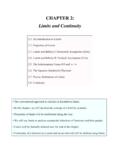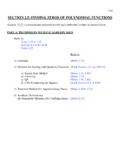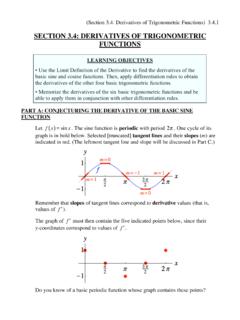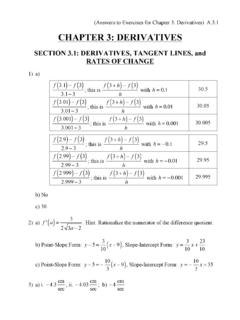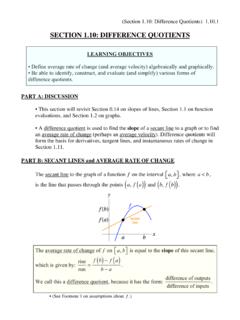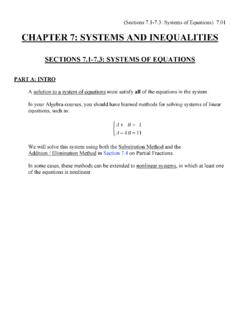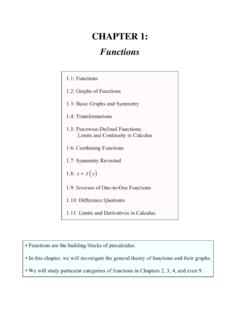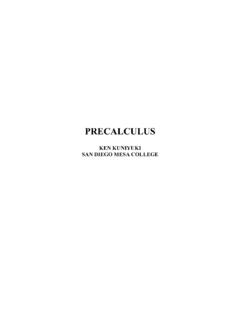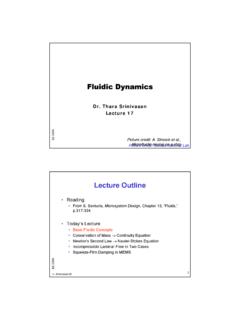Transcription of www.kkuniyuk.com
1 (Section : The squeeze (Sandwich) theorem ) SECTION : THE squeeze (SANDWICH) theorem LEARNING OBJECTIVES Understand and be able to rigorously apply the squeeze (Sandwich) theorem when evaluating limits at a point and long-run limits at ()infinity. PART A: APPLYING THE squeeze (SANDWICH) theorem TO LIMITS AT A POINT We will formally state the squeeze (Sandwich) theorem in Part B. Example 1 below is one of many basic examples where we use the squeeze (Sandwich) theorem to show that limx 0fx()=0, where fx() is the product of a sine or cosine expression and a monomial of even degree. The idea is that something approaching 0 times something bounded (that is, trapped between two real numbers) will approach 0. Informally, Limit Form 0 bounded() 0. Example 1 (Applying the squeeze (Sandwich) theorem to a Limit at a Point) Let fx()=x2cos1x.
2 Prove that limx 0fx()=0. Solution We first bound cos1x , which is real for all x 0. Multiply all three parts by x2 so that the middle part becomes fx(). WARNING 1: We must observe that x2>0 for all x 0, or at least on a punctured neighborhood of x=0, so that we can multiply by x2 without reversing inequality symbols. 1 cos1x 1 x 0() x2 x2cos1x x2 x 0() (Section : The squeeze (Sandwich) theorem ) As x 0, the left and right parts approach 0. Therefore, by the squeeze (Sandwich) theorem , the middle part, fx(), is forced to approach 0, also. The middle part is squeezed or sandwiched between the left and right parts, so it must approach the same limit as the other two do. limx 0 x2()=0, and limx 0x2=0, so limx 0x2cos1x =0 by the squeeze theorem . Shorthand: As x 0, x2 0 x2cos1x Therefore, 0by the squeeze (Sandwich) theorem x2 0 x 0().
3 The graph of y=x2cos1x , together with the squeezing graphs of y= x2 and y=x2, is below. (The axes are scaled differently.) (Section : The squeeze (Sandwich) theorem ) Example 2 below, fx() is the product of a sine or cosine expression and a monomial of odd degree. Example 2 (Handling Complications with Signs) Let fx()=x3sin1x3 . Use the squeeze theorem to find limx 0fx(). Solution 1 (Using Absolute Value) We first bound sin1x3 , which is real for all x 0. WARNING 2: The problem with multiplying all three parts by x3 is that x3<0 when x<0. The inequality symbols would have to be reversed for x<0. Instead, we use absolute value here. We could write 0 sin1x3 1 x 0(), but we assume that absolute values are nonnegative. Multiply both sides of the inequality by x3. We know x3>0 x 0(). The product of absolute values equals the absolute value of the product.
4 If, say, a 4, then 4 a 4. Similarly: 1 sin1x3 1 x 0() sin1x3 1 x 0() x3sin1x3 x3 x 0() x3sin1x3 x3 x 0() x3 x3sin1x3 x3 x 0() (Section : The squeeze (Sandwich) theorem ) Now, apply the squeeze (Sandwich) theorem . limx 0 x3()=0, and limx 0x3=0, so limx 0x3sin1x3 =0 by the squeeze theorem . Shorthand: As x 0, x3 0 x3sin1x3 Therefore, 0by the squeeze (Sandwich) theorem x3 0 x 0(). Solution 2 (Split Into Cases: Analyze Right-Hand and Left-Hand Limits Separately) First, we analyze: limx 0+x3sin1x3 . Assume x>0, since we are taking a limit as x 0+. We first bound sin1x3 , which is real for all x 0. Multiply all three parts by x3 so that the middle part becomes fx(). We know x3>0 for all x>0. Now, apply the squeeze (Sandwich) theorem .
5 1 sin1x3 1 x>0() x3 x3sin1x3 x3 x>0() limx 0+ x3()=0, and limx 0+x3=0, so limx 0+x3sin1x3 =0 by the squeeze theorem . Shorthand: As x 0+, x3 0 x3sin1x3 Therefore, 0by the squeeze (Sandwich) theorem x3 0 x>0().(Section : The squeeze (Sandwich) theorem ) Second, we analyze: limx 0 x3sin1x3 . Assume x<0, since we are taking a limit as x 0 . We first bound sin1x3 , which is real for all x 0. Multiply all three parts by x3 so that the middle part becomes fx(). We know x3<0 for all x<0, so we reverse the inequality symbols. Reversing the compound inequality will make it easier to read. Now, apply the squeeze (Sandwich) theorem . 1 sin1x3 1 x<0() x3 x3sin1x3 x3 x<0() x3 x3sin1x3 x3 x<0() limx 0 x3=0, and limx 0 x3()=0, so limx 0 x3sin1x3 =0 by the squeeze theorem . Shorthand: As x 0 , x3 0 x3sin1x3 Therefore, 0by the squeeze (Sandwich) theorem x3 0 x<0().
6 Now, limx 0+x3sin1x3 =0, and limx 0 x3sin1x3 =0, so limx 0x3sin1x3 =0. (Section : The squeeze (Sandwich) theorem ) Example 3 (Limits are Local) Use limx 0x2=0 and limx 0x6=0 to show that limx 0x4=0. Solution Let I= 1, 1()\0{}. I is a punctured neighborhood of 0. Shorthand: As x 0, x6 0 x4 Therefore, 0by the squeeze (Sandwich) theorem x2 0 x I() WARNING 3: The direction of the inequality symbols may confuse students. Observe that 12 4=116, 12 2=14, and 116<14. We conclude: limx 0x4=0. We do not need the compound inequality to hold true for all nonzero values of x. We only need it to hold true on some punctured neighborhood of 0 so that we may apply the squeeze (Sandwich) theorem to the two-sided limit limx 0x4. This is because Limits are Local. As seen below, the graphs of y=x6 and y=x2 squeeze (from below and above, respectively) the graph of y=x4 on I.
7 In Chapter 6, we will be able to find the areas of the bounded regions. (Section : The squeeze (Sandwich) theorem ) PART B: THE squeeze (SANDWICH) theorem We will call B the bottom function and T the top function. The squeeze (Sandwich) theorem Let B and T be functions such that Bx() fx() Tx() on a punctured neighborhood of a. If limx aBx()=L and limx aTx()=LL (), then limx afx()=L. Variation for Right-Hand Limits at a Point Let Bx() fx() Tx() on some right-neighborhood of a. If limx a+Bx()=L and limx a+Tx()=LL (), then limx a+fx()=L. Variation for Left-Hand Limits at a Point Let Bx() fx() Tx() on some left-neighborhood of a. \ If limx a Bx()=L and limx a Tx()=LL (), then limx a fx()=L. PART C: VARIATIONS FOR LONG-RUN LIMITS In the upcoming Example 4, fx() is the quotient of a sine or cosine expression and a polynomial.
8 The idea is that something bounded divided by something approaching ()infinity will approach 0. Informally, Limit Form bounded 0. (Section : The squeeze (Sandwich) theorem ) Example 4 (Applying the squeeze (Sandwich) theorem to a Long-Run Limit; Revisiting Section , Example 6) Evaluate: a) limx fx() and b) limx fx(), where fx()=sinxx. Solution to a) Assume x>0, since we are taking a limit as x . We first bound sinx. Divide all three parts by x x>0() so that the middle part becomes fx(). 1 sinx 1 x>0() 1x sinxx 1x x>0() Now, apply the squeeze (Sandwich) theorem . limx 1x =0, and limx 1x=0, so limx sinxx=0 by the squeeze theorem . Shorthand: As x , 1x 0 sinxxTherefore, 0by the squeeze (Sandwich) theorem 1x 0 x>0(). Solution to b) Assume x<0, since we are taking a limit as x . We first bound sinx.
9 Divide all three parts by x so that the middle part becomes fx(). But x<0, so we must reverse the inequality symbols. Reversing the compound inequality will make it easier to read. 1 sinx 1 x<0() 1x sinxx 1x x<0() 1x sinxx 1x x<0() (Section : The squeeze (Sandwich) theorem ) Now, apply the squeeze (Sandwich) theorem . limx 1x=0, and limx 1x =0, so limx sinxx=0 by the squeeze theorem . Shorthand: As x , 1x 0 sinxxTherefore, 0by the squeeze (Sandwich) theorem 1x 0 x<0()The graph of y=sinxx, together with the squeezing graphs of y= 1x and y=1x, is below. We can now justify the HA at y=0 (the x-axis). (The axes are scaled differently.) Variation for Long-Run Limits to the Right Let Bx() fx() Tx() on some x-interval of the form c, (), c . If limx Bx()=L and limx Tx()=LL (), then limx fx()=L. In Example 4a, we used c=0.
10 We need the compound inequality to hold forever after some point c. Variation for Long-Run Limits to the Left Let Bx() fx() Tx() on some x-interval of the form ,c(), c . If limx Bx()=L and limx Tx()=LL (), then limx fx()=L.
